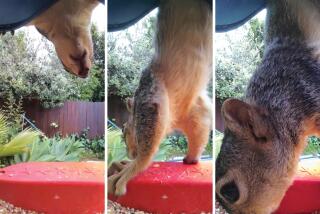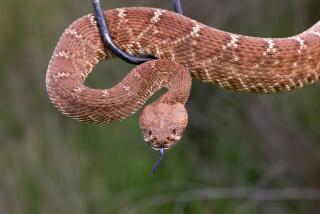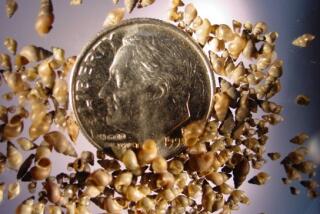Shell Knell : The crawling pest becomes just another link in the food chain when cousin decollates are introduced to the garden.
- Share via
The weather warms. Back-yard gardens and landscapes explode with vibrant summertime colors. The gardener sits back on the porch and as the sun sets, enjoys the scenery born from weed-picking, plant-pruning hard work.
But in this typical summer setting, danger lurks. Lying in wait for the cool of evening is an army of garden mollusks. Much to the chagrin of the garden hobbyist, the pesky brown snail greets the gardener the next morning with slime trails and conspicuous holes eaten into vegetation.
What to do? Reach for the poison pellet snail bait? If that’s an option you would rather not employ there’s always. . . more snails?
Enter the decollate snail--a predacious snail with an appetite for its brown cousin, and possibly the answer for those who wish to keep their landscape free from pesticides.
Where and how does one obtain decollate snails? The answer is a phone call away--or a trip to the Ventura Farmers Market.
Reed and Jan Finfrock, proprietors of the Sespe Creek Insectary, offer the decollate snail--which has a conical shell--via mail order. Jan Finfrock also has recently been offering supplies of the snail along with other goodies she sells at Ventura’s Farmers Market on Wednesdays.
Although the Sespe Creek Insectary offers various types of beneficial insects to farmers statewide, this is one combatant it sells to back-yard hobbyists.
“We sell to anybody who wants them,” Reed Finfrock said during a recent interview, “but most orders do go to the home gardeners.”
The decollate snail offers home gardeners a practical means of fighting off the pesky brown snail--a species that, left unchecked, can decimate vegetation.
To employ the decollate, which grows to about 2 inches, Finfrock said, the gardener’s ultimate goal should be to have a self-sustaining population that thrives in the garden beds.
That makes the snail less useful for seasonal vegetable growing grounds and others that require constant soil churning.
“This would be more for tree crops and shrubbery, where the snail can become well entrenched,” Finfrock said. “The row crops get tilled so much that the population never gets established.”
Armed with a raspy tongue, the decollate will feed upon the eggs of the brown snail or stalk its larger cousin and consume the flesh inside the semicircular shell.
To introduce the decollate, Finfrock suggests acquiring “a seed population.”
“What people are doing is buying a couple of hundred and basically growing their own, letting them reproduce and expand and take over.” Generally, he said, it takes two to five years to establish a decollate population that will devour the brown snail in numbers sufficient that you won’t have to employ other eradication methods.
“It’s not going to happen overnight,” he said. “It is an investment.”
Finfrock offered an easy suggestion to reduce brown snails while the decollate gains a foothold.
“It’s a matter of getting a few pieces of wood and setting them around where (brown) snails are heaviest,” Finfrock said. The wood, he added, should be no more than 1 inch thick.
“Raise the wood a half-inch above ground and the snails will accumulate under them during the day,” he said. “Just pick them off and toss away, but watch out for decollates because they too will accumulate.”
This is not just a snail-eating predator either. Finfrock said the decollate is a very versatile creature.
“They’ll consume dead leaves and other decaying vegetation on the ground, but present no danger to healthy plants, since they neither climb nor do they like thriving plants. Plus they burrow the ground, tilling the topsoil. It really reduces water runoff, and its fecal matter is a perfect fertilizer,” Finfrock said.
Its penchant for burrowing is a problem for some buyers, it seems.
“One of the big concerns at first is people wonder what happened to them. They burrow in the ground during the day and come out at night,” Finfrock said. “You don’t normally see them.”
If you’re wondering whether the decollate eats other things such as the slug, well, “No,” said Finfrock. “We don’t know what all types of snails they will consume, but the slug is not one of them.”
Finfrock said there isn’t much to starting your decollate population.
“Take them home and dump into the grounds, especially where the brown snails are concentrated.”
“As long as they are taken care of, they will reproduce on their own and migrate all over the garden.”
* FYI
To obtain a supply of decollate snails, call 524-3565 or visit Jan Finfrock at the Wednesday Ventura Farmers Market.






